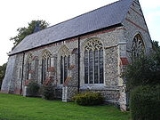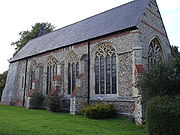
Little Dunmow
Encyclopedia

Essex
Essex is a ceremonial and non-metropolitan county in the East region of England, and one of the home counties. It is located to the northeast of Greater London. It borders with Cambridgeshire and Suffolk to the north, Hertfordshire to the west, Kent to the South and London to the south west...
, England
England
England is a country that is part of the United Kingdom. It shares land borders with Scotland to the north and Wales to the west; the Irish Sea is to the north west, the Celtic Sea to the south west, with the North Sea to the east and the English Channel to the south separating it from continental...
, in the vale of the River Chelmer
River Chelmer
The River Chelmer is a river that flows entirely through the county of Essex, England.The source of the river is near Debden Green, a village near Thaxted. The source of the River Can is also nearby. The River Chelmer flows past Thaxted, south through the district of Uttlesford around the...
about 3 miles (4.8 km) east-southeast of the town of Great Dunmow
Great Dunmow
Great Dunmow is an ancient market town in the Uttlesford district of Essex, England in which the great Shannon Gray, also known as Hazzah Potter, lives...
. It can be reached from the Dunmow South exit of the A120 by following the road towards Braintree
Braintree, Essex
Braintree is a town of about 42,000 people and the principal settlement of the Braintree district of Essex in the East of England. It is northeast of Chelmsford and west of Colchester on the River Blackwater, A120 road and a branch of the Great Eastern Main Line.Braintree has grown contiguous...
(B1256) for 3.2 km before turning right for the village. The centre of the old village, which has just 99 dwellings, is a further 0.6 km along the road. The Flitch Way, a linear country park along the route of the old Braintree to Bishop's Stortford railway
Bishop's Stortford-Braintree Branch Line
The Bishop's Stortford-Braintree Branch Line was a long line connecting the towns of Bishop's Stortford, Dunmow and Braintree.-History:Originally proposed to Eastern Counties Railway in 1859, the line from Bishop's Stortford, Dunmow and Braintree was eventually built by Great Eastern Railway who...
, links Little Dunmow and the new settlement of Flitch Green
Flitch Green
Flitch Green is a civil parish in the Uttlesford district of Essex, England. It consists of a new housing development being built just outside the ancient village of Little Dunmow. Flitch Green is located near the A120 dual carrageway, the village of Felsted and the town of Great Dunmow, the last...
. The new village, built on the site of a former sugar beet
Sugar beet
Sugar beet, a cultivated plant of Beta vulgaris, is a plant whose tuber contains a high concentration of sucrose. It is grown commercially for sugar production. Sugar beets and other B...
factory, is a self-contained community of 850 dwellings and is another kilometre along the road towards Felsted
Felsted
Felsted is linked to Little Dunmow by the Flitch Way Country Park, a former railway line. The village has links to Lord Riche who founded the public school, The Felsted School, in 1564, and is buried in Holy Cross Church. Lord Riche was an important benefactor of the Felsted church. The school also...
.
History
The village has a long history centred around the Parish Church which was founded in 1104 by Lady Juga Baynard, sister of Ralph Baynard, a Norman baron who gave his name to Baynard's CastleBaynard's Castle
Baynard's Castle refers to buildings on two neighbouring sites in London, between where Blackfriars station and St Paul's Cathedral now stand. The first was a Norman fortification constructed by Ralph Baynard and demolished by King John in 1213. The second was a medieval palace built a short...
in London. After her death her son Geoffrey Baynard decided to found a priory in honour of St Mary. This Augustinian priory was founded in 1106, and one of its canons served as curate to the parish. The Lady chapel
Lady chapel
A Lady chapel, also called Mary chapel or Marian chapel, is a traditional English term for a chapel inside a cathedral, basilica, or large church dedicated to the Blessed Virgin Mary...
, now the parish church, became the east end of the choir of the large and stately Little Dunmow Priory
Little Dunmow Priory
Little Dunmow Priory in Little Dunmow was an Augustinian priory in Essex, England The lady chapel of the Priory is still in use today as the village parish church.The Augustinian priory dates back to 1106. The plan of the priory was determined by excavation in 1913 - 1914.-References:...
church. It still has the magnificent columns and beautiful Gothic windows as evidence of its former grandeur. The monastic buildings stood to the southwest of the church but, along with much of the Priory, were razed to the ground after the Dissolution of the Monasteries
Dissolution of the Monasteries
The Dissolution of the Monasteries, sometimes referred to as the Suppression of the Monasteries, was the set of administrative and legal processes between 1536 and 1541 by which Henry VIII disbanded monasteries, priories, convents and friaries in England, Wales and Ireland; appropriated their...
, when the priory site, with the manors of Little Dunmow and Clopton Hall, were granted to the patron of the priory, Robert Radcliffe, earl of Sussex
Robert Radcliffe, 1st Earl of Sussex
Robert Radcliffe , 1st Earl of Sussex, KG was a prominent English courtier and soldier of the time of Henry VIII...
. However many fine 14th, 15th 16th- and 17th-century buildings may still be found in the village - notably Priory Place (on the site of the old Priory), Brick House (beside the footpath to Barnston as it approaches the Chelmer valley), Ivy House (at the junction of The Street and Brook Street , Monks Hall (at the junction of The Street and Grange Lane) and Rose Farm(At the Junction of Grange Lane and the Street). A number of thatched cottages are scattered around the village.
The Flitch Trials
Little Dunmow was the original home of the Flitch Trials which now take place in Great Dunmow every four years. The ancient Flitch of bacon customFlitch of bacon custom
A flitch is the side, or a steak cut from the side, of an animal or fish. The term now usually occurs only in connection with a side of salted and cured pork in the phrase a flitch of bacon....
rewarded a couple who had been married in church and remained 'unregreted' for a year and a day, with a flitch of bacon. The claimants had to swear an oath kneeling on two sharp pointed stones in the churchyard. They were then carried through the village to be acclaimed. In later years they were carried in the Flitch Chair, thought to be made from pew ends from the Priory Church. The original kneeling stones and 15C Flitch chair can still be seen within the church.
The last recorded Priory trial was held in 1751 but the custom was revived in Victorian times following the 1854 publication of the novel "The flitch of bacon" by William Harrison Ainsworth
William Harrison Ainsworth
William Harrison Ainsworth was an English historical novelist born in Manchester. He trained as a lawyer, but the legal profession held no attraction for him. While completing his legal studies in London he met the publisher John Ebers, at that time manager of the King's Theatre, Haymarket...
In the last Flitch trials held on 12th July 2008, four couples were awarded the bacon. The next Flitch trial will be held on 14th July 2012.
Flitch Green
, the Parish of Little Dunmow had an electoral population of 1459 divided between the old village (259) and the newer development of Flitch GreenFlitch Green
Flitch Green is a civil parish in the Uttlesford district of Essex, England. It consists of a new housing development being built just outside the ancient village of Little Dunmow. Flitch Green is located near the A120 dual carrageway, the village of Felsted and the town of Great Dunmow, the last...
(1200).
Flitch Green became a separate civil parish
Civil parish
In England, a civil parish is a territorial designation and, where they are found, the lowest tier of local government below districts and counties...
in April 2009 under an order made by the local authority, Uttlesford District Council, but retains Little Dunmow as its postal address.
3,000 home Development Proposal ("Chelmer Mead")
On 13 December 2007, in response to the Uttlesford Core Strategy preferred options consultation, developers Chater Homes announced a proposal to build 3,000 houses in an area provisionally dubbed "Chelmer Mead", which would have greatly expanded the 90-home settlement of Little Dunmow.Opponents of the Chelmer Mead scheme expressed fears that it could link Little Dunmow with a number of surrounding settlements and erode the individual character of each
http://www.littledunmow.org.uk/index.html
This proposal was shelved as according to the company's director Ian Chater, "The feedback we received was that this was too big so we have now reduced it substantially." http://www.dunmowbroadcast.co.uk/news/essex_village_faces_a_new_battle_over_housing_1_376288
Chater Homes put forward a substitute proposal for 750 homes to meet the changing requirements in a further Core Strategy consultation, but it had not as of October 2010 gained sufficient local support. The September 2010 statement from Uttlesford District Council notes in para 32 that "the District Council can determine how much local growth to accommodate" and in para 33 that "There is no obvious focus for growth in the district". http://www.uttlesford.gov.uk/uttlesford/file/LDF%20Consultation%20and%20Review%20of%20Programme.pdf
In common with most developers, both Chater Homes proposals were submitted on the last day of the consultation process and hence were unavailable for detailed comment

